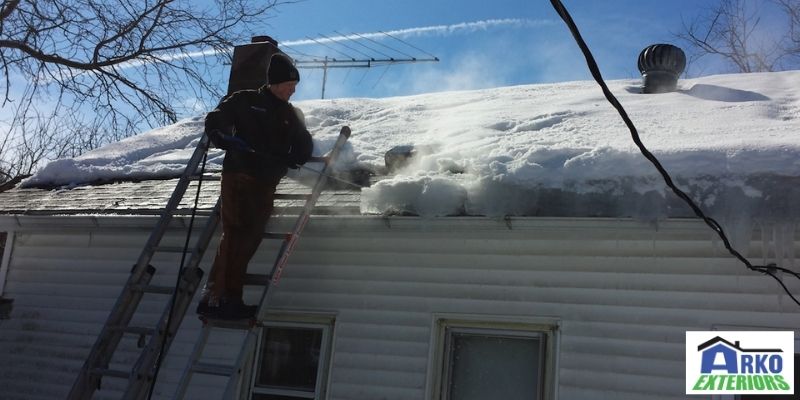Ice tends to collect near the edges of some roofs. Your roof may face unnecessary wear and tear if you do not remove ice dams. There is also the chance that your roof will develop a leak if you do not remove the ice dams on it.
Ways To Remove Ice Dams

Certain ice dam removal methods may damage your roof.
These are the best ways to remove ice dams from the roof of your home…
1. Use Warm Water
Gently running warm water over the ice dams on your roof will cause them to melt. As a result, water will drain into the gutters. Although this is a stopgap solution, the result it produces is immediate.
You can pour the warm water you want to use into a spraying device such as a lawn fertilizer canister or a large spray bottle. Spray the water over the ice. This will loosen it up and cause it to melt.
As it melts, ensure that the water drains off your gutter properly. This is because the water may eventually become cold and freeze again if the temperature is still low.
2. Install Heat Cables
Another safe and good way of removing ice dams is by installing heating cables on your roof. Get the installation done in the summer. The heat cables will be there to melt the ice during cold weather.
Your roofer may recommend that you either install them permanently or use them temporarily. Permanently installing heat cables is a good way of avoiding ice dams. Installing heat cables on your roof will prevent ice dams from forming.
3. Blow Cold Air Thru The Attic
One cause of ice dams is the rising of hot air through your roof. The heat melts the snow on your roof, causing it to slide off to the unheated cold edges and eaves. The melted snow refreezes around your gutters and beneath the shingles. Try blowing cold air thru your attic using a fan to help keep your roof cooler rather than hotter in order to prevent ice dams.
4. Warmer Weather
Ice dams will likely melt with warmer weather. However, a roofer may choose to remove the snow/ice anytime. This removal is to ensure that the snow that melts under the sun does not form ice dams when it slides and refreezes at the colder eaves of your roof.
Additionally, it is recommended that to prevent damage to the shingles, you should leave some snow on your roof. Leaving some snow will ensure that the shovel of the contractor does not touch your roof in the process of scraping it.
It’s recommended that you hire a professional if there is a need to remove ice (or snow) from your roof.
5. Call A Professional

You should contact a professional roofer if you cannot effectively deal with the ice dam yourself. Roofers have the experience and right tools to use for removing ice dams.
Many methods of removing ice dams are strenuous, exhausting and require time before the job is completely done.
A professional will use ice removal methods that are not harmful to your roof.
Ice Dam Removal Methods To Avoid
Not all ways of removing ice dams are safe. Some removal methods can cause damage to your asphalt shingles. You can also compromise the water-shedding ability of your roof.
Using chemicals to remove ice dams on your roof is risky. Roofers should avoid it. The combination of salt and other chemicals in many ice-melts products makes them an effective de-icing treatment for ice dams. There are even targeted ice-melt tablets for ice dams. However, many of these chemicals are not good for your roof.
Then there’s the idea of picking up a hammer, shovel or any other tool to chip off an ice dam yourself, manually, and this is not a good idea. You may end up damaging your shingles if you use any of these tools to remove ice dams (or even snow) from your roof.
Conclusion
Ice dams can affect the integrity of your roof. It is therefore critical that you assess the cause. However, you must get rid of any ice dams already on your roof in the best ways possible. Doing so will ensure that your roof is not negatively affected because of ice removal. Need a professional to do the job? Arko Exteriors knows all about fixing ice dam problems in Minnesota!

